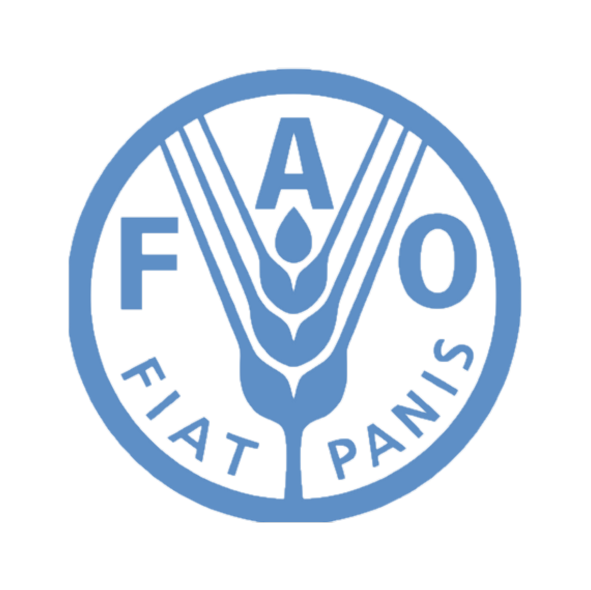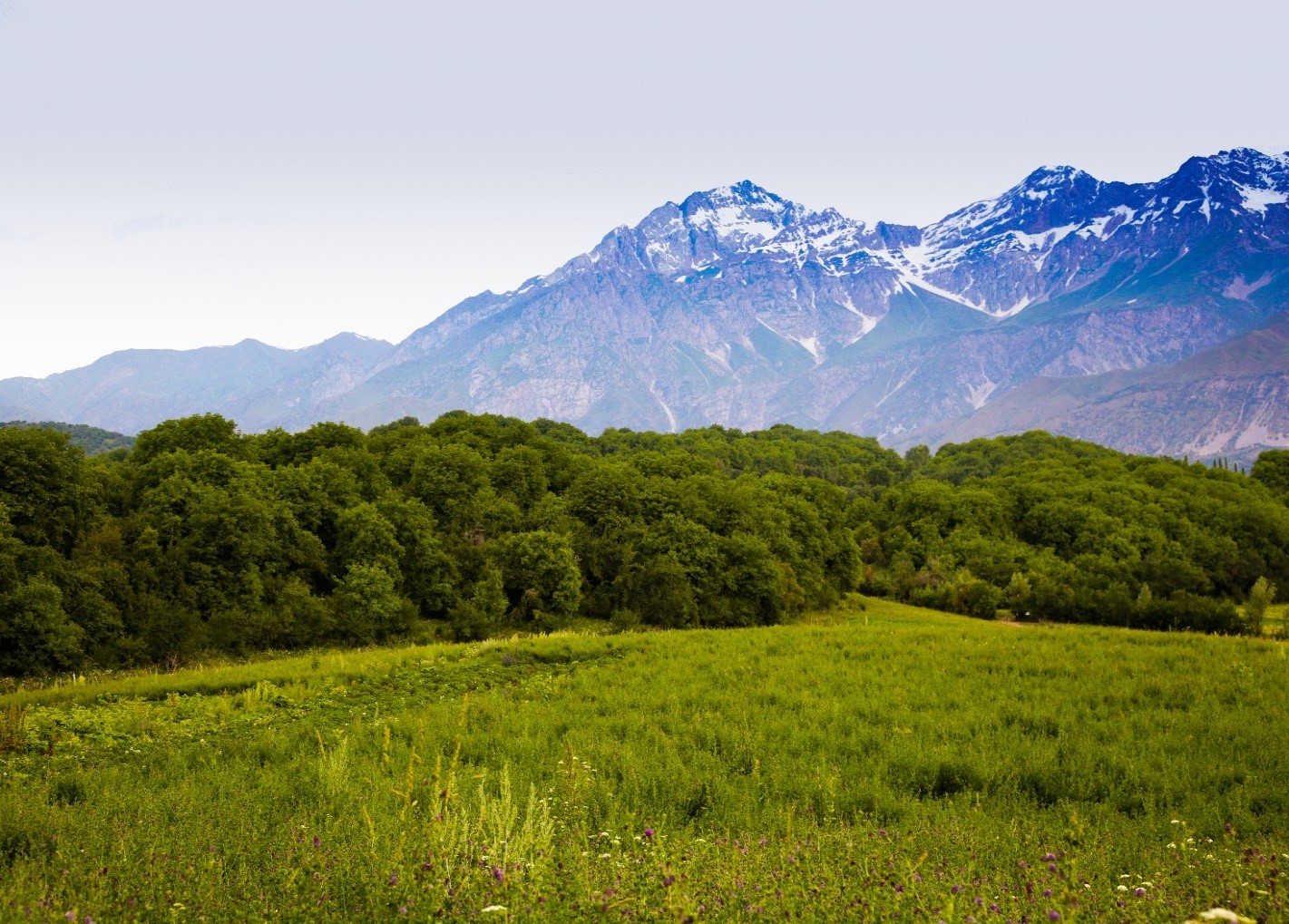
Country Profile: Kyrgyzstan

Surface area: 199.9 thousand sq. km
Population, total: 6636.8 million
Population density: 33 people per sq. km of land area
Human Development Index (value): 0.697
Share of rural population: 65.6%
Approximately 25,3% of population lives below the poverty line, and 75% of the country’s poor people live in rural areas, often in remote, mountainous regions with limited infrastructure and market access.
GDP per capita: 1,175 USD
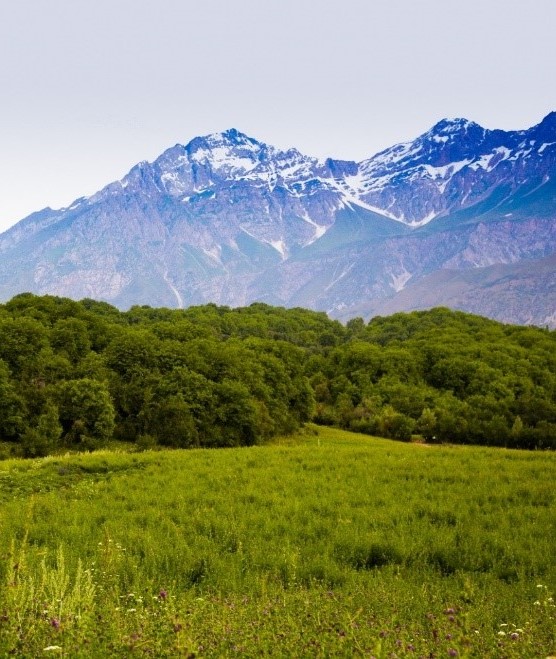
Forest cover: 5.61%* (according to national inventory in 2011), 6.04% (most recent estimation)
Forest area: 1116.56* thousand ha (according to national inventory in 2011)
Around 90% of the forest located between 700 and 3500 m above sea level.
Share of protected forests: 4.22% (839.56 thousand hectares)
Forest-dependent population: more than 2 million of the rural population – aiyl aimags – live near forest or on the territory of the state forest fund. Their livelihoods are highly dependent on forest resource use.
Major drivers of forest degradation and deforestation:
- increasing of livestock production and intensive cattle-grazing in or near forest
- illegal logging
- high demand for firewood
- overharvesting of non-timber forest (e.g., walnuts, mushrooms and medical plants)
- construction of settlements and road building
- clearing forestland for cultivation
- climate change

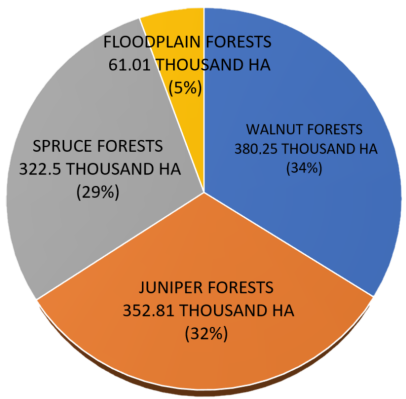

Forest ownership: 100% owned by the state
Forest management bodies: the State Forestry Agency under the Ministry of Agriculture, the Ministry of Natural Resources, the Office of the President, local authorities and municipalities.
Management is typically in the hands of leskhoz (autonomous local enterprises), which answer to the Ministry of Agriculture and are partly funded by it. In most cases the leskhoz depend on their own commercial activities for most of their revenue.
Responsibility for policy formulation: State Forestry Agency under the Ministry of Agriculture
Forest policy objectives: national forest policy is focused on forest protection, climate change adaptation, disaster risk reduction and sustainable forest management.
Sustainable forest development includes three aspects of sustainability:
- Economic: increasing the contribution of forestry to the country's GDP up to 1% by 2040
- Social: reducing the poverty level of the rural population of forest areas by 10% by 2040
- Environmental: forest protection and increase of forest area up to 6.5% by 2040.
Main policy documents: Forest Code (1999), Concept of Forestry Development until 2040; Action Plan for the implementation of the Concept for 2019- 2023; National Development Strategy of the Kyrgyz Republic for 2018-2040.
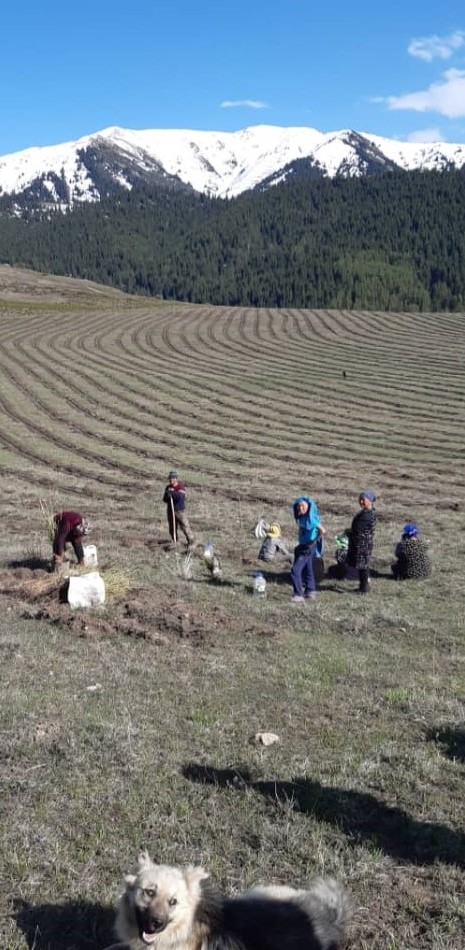
Share of degraded forest: about 70%
Natural and artificial reforestation is slow. Degradation is observed in the age structure. Mature and overmature stands account almost 37% of the total forest, and the area of young stands is 16%.
Implemented restoration:
From 2009 to 2018: reforestation activities occured on a total area of 17,632.6 ha
From 2018 to 2021:
- planting forest crops and sowing on the area of 6385 ha
- assistance to natural regeneration on the area of 17.76 thousand ha
- growing of planting material in the amount of 60299 thousand pieces
Restoration needs: walnut forests (Jalal-Abad oblast), juniper forests (Batken and Osh oblasts), spruce forests (Issyk-Kul, Naryn, Chui oblasts) and floodplain forests (Talas oblast)
Country target for forest restoration/ afforestation: yearly target for forest restoration/ afforestation is 1,100 hectares
Restoration potential: A preliminary estimate suggests reforestation activities might be done on more than 200 thousand hectares. A study is needed to examine the compliance of these lands with the afforestation needs and species composition (exposure and steepness of the slope, soil characteristics, etc.). Read more
State budget annually allocates funding to carry out silvicultural and forest protection measures (according to the Law of the Kyrgyz Republic "On the Republican Budget of the Kyrgyz Republic for 2020 and forecast for 2021-2022").
To implement forest restoration activities completed by the forestry enterprises, forest nurseries have been established on the total area of 140 hectares (with about 15 million seedlings and saplings of various tree and shrub species) and more than 25 tons of seeds are harvested annually. Forestry enterprises carry out restoration and afforestation activities on the area of more than 1,100 hectares.
Restoration challenges: financing (donor funds and private investments).
To attract donor funds and private investments for reforestation activities, it is planned to prepare a map with the locations and coordinates of the areas, reforestation is possible and share it on the official website of the State Forestry Agency.
Forest monitoring shows that the processes of natural regeneration in forests are weak, and the increase in forest-covered area due to forest reproduction (reforestation, afforestation) is slow.
Annual projects to establish forest and promote natural regeneration contribute to forest preservation and increasing forest area. One adaptation priority of the forest industry is to create artificial plantations, for which there is already appropriate infrastructure: seed plots, storage facilities, a seed quality laboratory, nurseries, and the necessary silvicultural fund. Carrying out silvicultural work in the context of climate change requires revising and adapting technology and methods for creating forest on rainfed lands with rainwater nutrition. It also requires shifting the focus to creating plantations with artificial irrigation from small natural or artificial reservoirs and watercourses;
The continuing increase in the number of livestock aggravates the degradation in the forest pastures of Kyrgyzstan. In recent years, due to the increase in the number of livestock, planting and sowing forest crops without installing fences around them lead to damage by cattle and their subsequent death of the crops. Installing fences around plantings increases the cost of planting forests. Between 2017 and 2021, fences were installed on more than 5402 hectares of planted forest through donor-funded projects;
Due to increased human pressure on forest resources, the Republic's forestry sector requires appropriate reforms to expand the involvement and responsibility of local communities for sustainable forest management and restoration. It is necessary to strengthen the cooperation with local authorities to improve relationships with and involvement of local communities in sustainable forest management and forest ecosystem preservation.
The current system of forestry financing and receipts from economic activities of forestry are strictly regulated by fiscal legislation. This does not provide incentives to improve the efficiency of forest management. Since 2017, when new Budget Code of the Kyrgyz Republic came into force, funds that do not fall under the definition of funds accumulated in special accounts re-qualified as non-tax income (lease of lands of the state forest fund, pastures, claims and other income) are included in the income of the Republic’s budget. This has led to loss of motivation in forestry workers and failure to complete planned reforestation activities
The lack of financing from the state budget indicates the need to increase the efficiency of state investments, expand the economic opportunities of forestry, and attract private investments for forestry activities.
Forestry management would be improved through analyzing the current situation, transferring work to the private sector, and creating a financing plan to make this possible.
The COVID-19 pandemic is one reason reforestation plans in Kyrgyzstan have not been completed on time. The country is forced to divert finances from reforestation to responding to the pandemic.
Forest sector workers lack knowledge, competence, and professionality. Low salaries result in staff turnover. It is necessary to raise the social status of forestry workers by raising wages and strengthening social security payments for forest workers and their families. To retain young personnel in the forestry sector, concessional lending programs are needed, which exist for agriculture and education in Kyrgyzstan.
Fruit trees (apricots), fast-growing plantations (poplar) with irrigation, and long-term land leases to private investors (tenants) could contribute to afforestation. In order to develop unproductive lands in the arid Issyk-Kul region, apricot plantations have been planted on more than 500 hectares. There is potential for an additional 600 hectares of apricot plantations.
Black saxaul was sown on more than 1200 hectares to develop unproductive lands in the south of the republic in the border areas with Uzbekistan and Tajikistan, as well as combating desertification by forestry in the arid lands of the Batken region. If local authorities provide lands with a very low bonitet* for sowing black saxaul, there is a possibility of sowing 500 hectares annually.
Degraded walnut forests could be rehabilitated with integrated management plans, restoration measures, and agroforestry. Expanding nut plantations, increasing productivity of existing plantations, preserving natural forests, and creating plantations with local varieties, and promoting natural regeneration would enable the walnut industry to respond to the growing demand for environmentally friendly products. The area to be restored is 5 thousand hectares.
Temporary bans on livestock grazing, building bridges and roads to increase access of alternative grazing sites, and creating pasture management plans could contribute to forest landscape restoration. Measures to restore rangelands are planned on 150,000 hectares of forest pastures of the state forest fund and on 150,000 hectares outside the state forest fund.
The approved state budget funds annual forest planting on 1100 hectares.
Integrated natural resource management plans could be designed to plant and fence pistachios. There is potential to restore 3000 hectares of pistachio.
* a term used to describe the potential for tree growth


